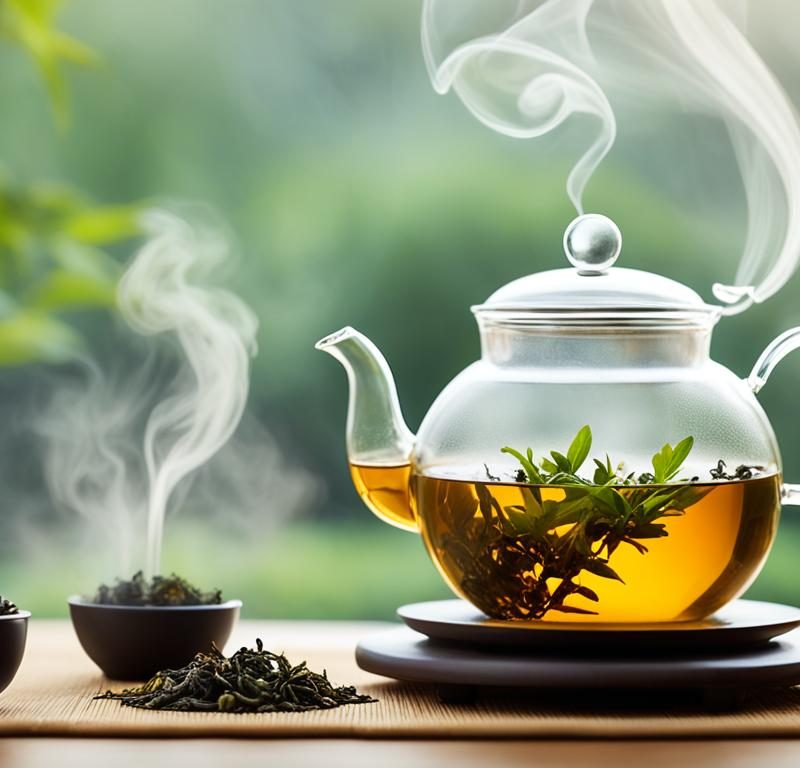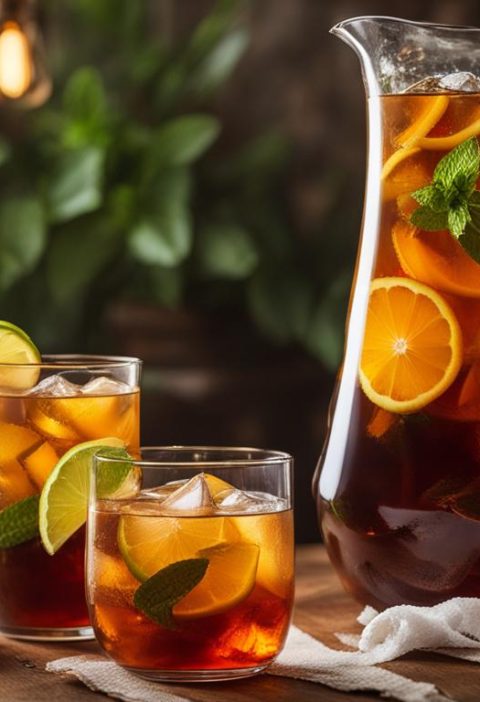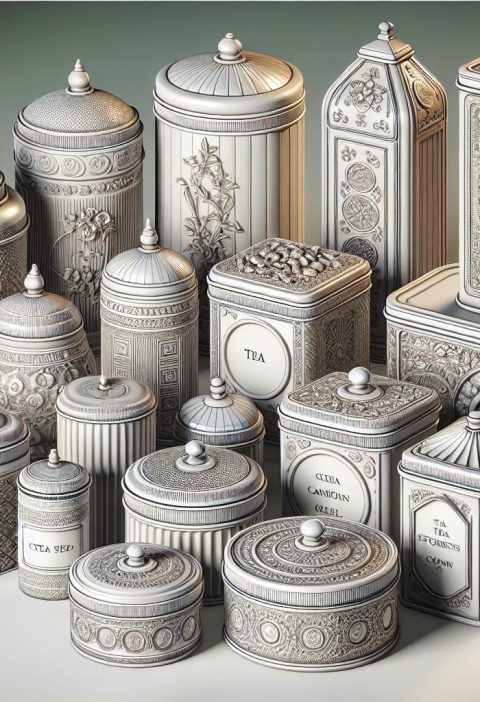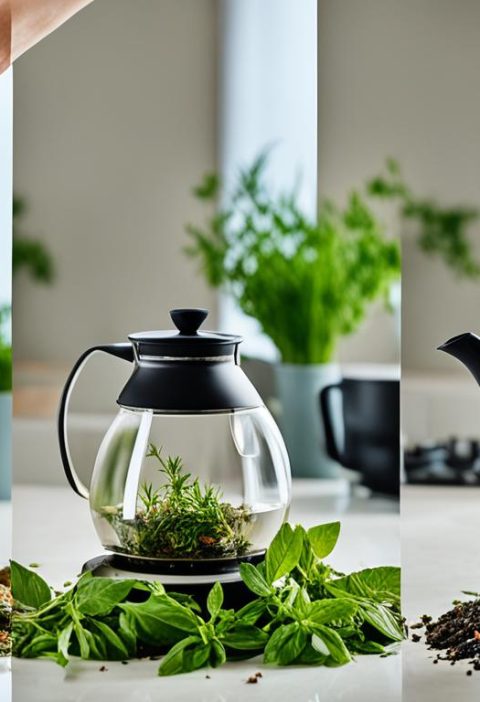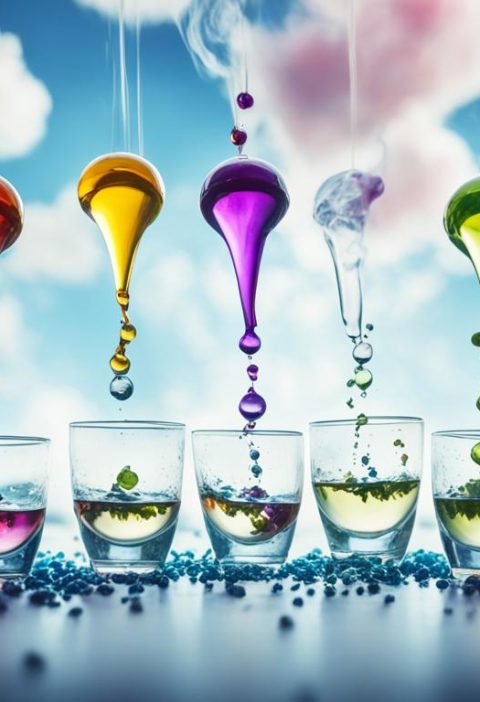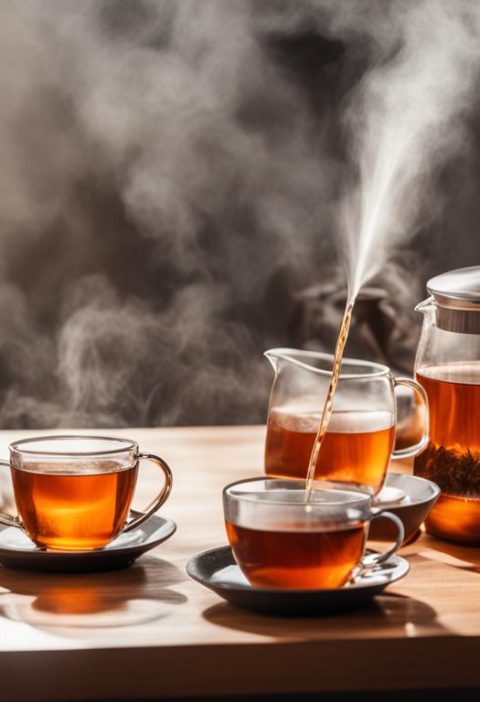Oolong tea steeping is an art form that requires precision and attention to detail. To achieve the perfect cup of oolong tea, it’s important to understand the unique steeping technique that sets it apart from other types of tea. By following this comprehensive guide, you’ll be able to master the art of oolong tea steeping and savor the sublime flavors of this beloved tea.
Key Takeaways:
- Choose the right vessel for steeping oolong tea, such as a gaiwan or Yixing clay teapot.
- Use fresh, filtered or spring water at the ideal temperature of 185-205°F.
- Experiment with different steeping times and reinfusions to unlock the full flavor of oolong tea.
- Explore the traditional Gong Fu and simplified Grandpa style brewing methods.
- Try cold brewing oolong tea for a refreshing and less caffeinated alternative.
Choosing the Right Vessel for Steeping Oolong Tea
When it comes to steeping oolong tea, selecting the right vessel is essential. The choice of vessel can significantly impact the flavor and overall experience of your oolong tea. Two popular options for oolong tea steeping are gaiwans and Yixing clay teapots.
Gaiwans are traditional Chinese teacups with lids. They are versatile and allow for a hands-on brewing experience. The wide shape and open design of a gaiwan provide ample space for oolong tea leaves to expand during steeping, allowing for a more thorough extraction of flavors. Gaiwans are especially suitable for teas with larger leaves, such as Tie Guan Yin or Da Hong Pao.
Yixing clay teapots are revered for their craftsmanship and ability to enhance the flavors of oolong tea. These pots are made from a special type of clay found in the Yixing region of China and are specifically designed for brewing tea. Yixing clay teapots have excellent heat retention properties, which helps to develop the complexity and depth of oolong tea’s flavors over time.
Regardless of the vessel you choose, ensure that its size is practical and allows enough room for the leaves to unfurl and release their flavors. Aim to fill the vessel with about one third of its capacity, using a generous amount of oolong tea leaves. This will provide the optimal leaf-to-water ratio for a flavorful brew.
To recap:
- Consider using a gaiwan or Yixing clay teapot for steeping oolong tea.
- Gaiwans allow for hands-on brewing and are suitable for teas with larger leaves.
- Yixing clay teapots enhance the flavors of oolong tea over time.
- Choose a vessel that provides enough room for the leaves to unfurl.
- Fill the vessel with about one third of its capacity for a flavorful brew.
| Gaiwan | Yixing Clay Teapot |
|---|---|
| Traditional Chinese teacup with a lid | Made from Yixing clay for enhanced flavor |
| Versatile and suitable for teas with larger leaves | Excellent heat retention for developing complex flavors |
| Provides ample space for tea leaves to expand during steeping | Specifically designed for brewing tea |
Water Temperature and Quality
When it comes to steeping oolong tea, the quality of water and the temperature at which it is steeped are crucial factors that can greatly impact the flavor of the brew. Using fresh, filtered, or spring water is recommended to ensure the best results. The choice of water can influence the taste and overall experience of enjoying oolong tea.
For optimal flavor extraction, it is important to steep oolong tea at the right temperature. The ideal water temperature for oolong tea generally falls in the range of 185-205°F (85-96°C). This temperature range allows the leaves to release their flavors and characteristics without scorching or diminishing the delicate nuances of the tea.
To ensure accuracy in determining water temperature, it is recommended to use a thermometer specifically designed for measuring tea temperatures. If a thermometer is not available, one can allow boiled water to cool for a few minutes before pouring it over the tea leaves. It is important to be mindful of the steeping temperature as it directly impacts the taste and aroma of the oolong tea.
| Water Temperature | Flavor Profile |
|---|---|
| 185°F (85°C) |
|
| 195°F (90°C) |
|
| 205°F (96°C) |
|
By maintaining the correct water temperature and using high-quality water, you can unlock the true flavors and nuances of oolong tea. Experimenting with different water temperatures can also provide a diverse range of taste experiences, allowing you to tailor your oolong tea steeping to your preference.
Steeping Time and Reinfusions
The steeping time for oolong tea can vary depending on personal preference and the type of oolong tea being brewed. While some tea labels may suggest steeping for 1 to 2 minutes, it’s important to remember that oolong tea is versatile, and experimenting with different steeping times can lead to exceptional flavors.
To fully explore the evolving flavors of oolong tea, consider reinfusing the same tea leaves multiple times. By gradually shortening and lengthening the steeping times with each infusion, you can uncover new dimensions of taste and aroma.
Here is a general guide for steeping times and reinfusions:
| Infusion | Steeping Time | Notes |
|---|---|---|
| First Infusion | 1 to 2 minutes | Start with the recommended steeping time for the specific oolong tea you are brewing. This allows the leaves to unfurl and release their flavors. |
| Second Infusion | 30 seconds to 1 minute | With each subsequent infusion, shorten the steeping time. This helps to extract different flavor profiles from the leaves. |
| Third Infusion | 1 to 2 minutes | Begin gradually lengthening the steeping time for subsequent reinfusions. This allows the leaves to fully release their flavors. |
Remember, these are just guidelines, and you can adjust the steeping times based on your personal taste preferences. It’s also recommended to taste the brew at different stages to experience the layers of character that oolong tea offers.
By exploring the intricacies of steeping time and reinfusions, you can unlock the perfect infusion of oolong tea, revealing its rich and complex flavors.
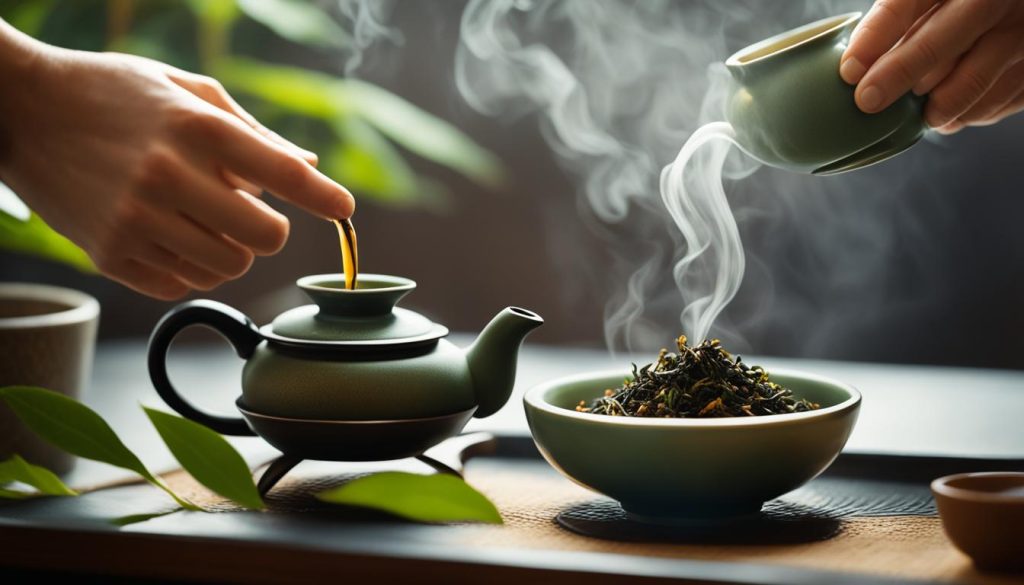
Gong Fu Style Brewing for Oolong Tea
If you’re looking to truly savor the flavors and aromas of oolong tea, Gong Fu style brewing is the way to go. This traditional method involves steeping small amounts of concentrated tea for short intervals, allowing you to capture the subtle and intricate essences released from the tea leaves.
The Gong Fu style brewing technique is typically done using a small teapot or gaiwan, adding to the authenticity and experience of this brewing method. The use of smaller vessels allows for better control over the taste and strength of the tea, ensuring that you can fully explore the nuances and complexities of oolong tea.
One of the key features of Gong Fu style brewing is the process of multiple infusions with gradually increasing steeping times. With each infusion, the flavors and characteristics of the oolong tea evolve, offering a deeper exploration of the tea’s unique profile.
To get started with Gong Fu style brewing, follow these simple steps:
- Preheat your teapot or gaiwan by rinsing it with hot water. This helps to ensure that the temperature remains consistent during the brewing process.
- Add a generous amount of oolong tea leaves to your teapot or gaiwan. The recommended ratio is approximately 1 gram of tea leaves per 20 milliliters of water.
- Pour hot water over the tea leaves, filling the vessel to the desired level. The water should be heated to the recommended temperature for oolong tea, which is between 185-205°F.
- Allow the tea leaves to steep for a short period of time, typically between 10-30 seconds for the first infusion. The exact steeping time can vary depending on the type of oolong tea and your personal preference.
- Pour the tea into small cups, distributing the flavorful brew evenly among each cup.
- For subsequent infusions, increase the steeping time by a few seconds with each infusion. This gradual increase allows you to fully extract the flavors from the tea leaves without oversteeping.
By following these simple instructions, you can experience the art of Gong Fu style brewing and unlock the true potential of your oolong tea. Take your time to savor each infusion, appreciating the delicate flavors and aromas that make oolong tea a favorite among tea enthusiasts.
Why Gong Fu Style Brewing?
Gong Fu style brewing offers a unique and immersive tea experience. By brewing in smaller quantities and shorter intervals, you can extract the full range of flavors and aromas from the oolong tea leaves and appreciate the depth and complexity that this tea has to offer. The multiple infusions with gradually increasing steeping times allow you to explore the tea’s evolution and enjoy the subtle differences that each cup brings.
Grandpa Style Brewing for Oolong Tea
When you’re short on time or only need a single serving of oolong tea, grandpa style brewing is the perfect method. This simplified approach involves using fewer tea leaves and more water for longer brewing times. Here are the step-by-step instructions for brewing oolong tea in grandpa style:
- Start by putting the desired amount of loose leaf oolong tea directly into a mug. The recommended proportion is about 1 part tea leaves to 40 parts water.
- Fill the mug with freshly boiled water. For the best results, ensure the water is at the ideal oolong tea brewing temperature, between 185-205°F.
- Allow the tea leaves to steep in the hot water. Unlike other brewing methods, there’s no need to remove the leaves. They will continue to infuse the water as you sip.
- As you drink the tea, refill the mug with hot water to maintain the desired strength. This process can be repeated multiple times for more servings.
Grandpa style brewing offers a convenient and fuss-free way to enjoy the delicate flavors of oolong tea. By adjusting the amount of tea leaves and water, you can customize the strength of each cup to suit your preferences. Try experimenting with different oolong tea varieties and find your perfect balance!
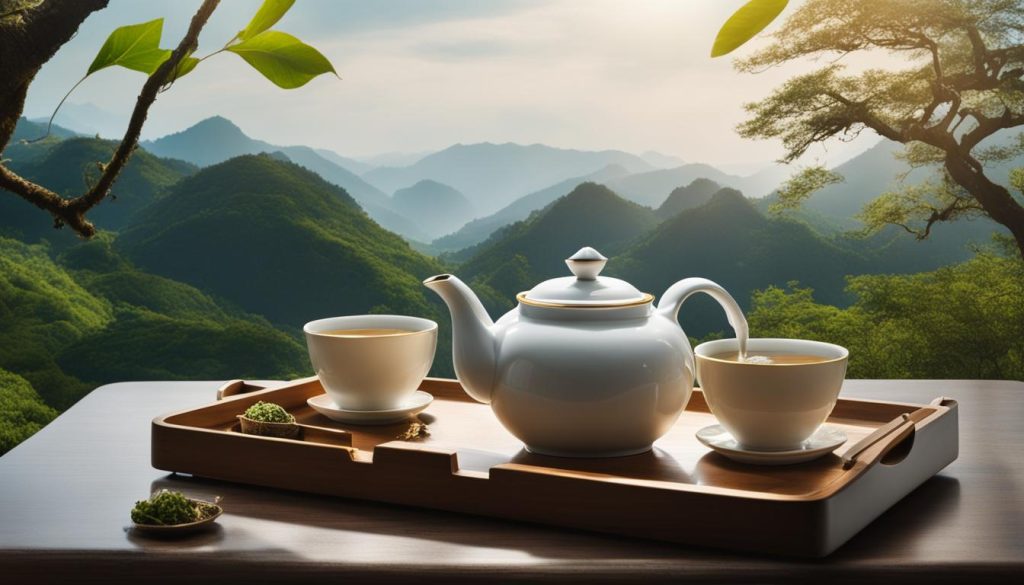
Comparing Brewing Methods
| Brewing Method | Tea to Water Ratio | Steeping Time | Additional Equipment |
|---|---|---|---|
| Gong Fu Style | High | Short | Small teapot or gaiwan |
| Grandpa Style | Low | Long | Mug or glass |
| Cold Brew | Medium | Long | Sealed container or pitcher |
Each brewing method has its unique advantages and produces distinct flavors. While gong fu style allows for a more controlled brewing process and highlights the tea’s nuances, grandpa style offers simplicity and convenience. Cold brewing, on the other hand, yields a refreshing and less caffeinated brew. Choose the method that suits your preferences and enjoy the art of oolong tea steeping!
Brewing Oolong Tea in a Gaiwan Tea Set
Brewing oolong tea in a gaiwan tea set follows a similar process to brewing in a teapot. The proportion of tea leaves to water is the same, and the steeping time can be adjusted to suit personal taste preferences. A gaiwan consists of a lidded bowl and a saucer, and it allows for a more controlled and traditional brewing experience. The brewed tea is poured into the small tea cups from the gaiwan, ensuring an even distribution of flavor among each cup.
Cold Brew Method for Oolong Tea
When it comes to steeping oolong tea, the cold brew method offers a unique and refreshing alternative. This method involves using room temperature or cold water to slowly infuse the tea leaves, resulting in a smoother and less caffeinated brew. Cold brewed oolong tea is perfect for hot summer days or when you’re looking for a milder flavor profile.
To cold brew oolong tea, follow these simple instructions:
- Choose a clean and spacious container, such as a mason jar or a pitcher.
- Add a generous amount of oolong tea leaves to the container. The ratio of tea leaves to water can vary depending on personal preference, but a good starting point is 1 tablespoon of tea leaves for every 8 ounces of water.
- Fill the container with room temperature or cold water, making sure to fully submerge the tea leaves.
- Cover the container and let it steep for at least 2-3 hours at room temperature or overnight in the refrigerator to allow the flavors to fully develop.
- Once the steeping time is complete, strain the tea leaves and transfer the cold brewed oolong tea to a serving pitcher or individual glasses.
- Enjoy the refreshing and smooth flavors of your homemade cold brewed oolong tea!
Cold brewing is a versatile method that allows you to experiment with different oolong tea varieties and flavor profiles. By adjusting the steeping time or the amount of tea leaves used, you can create a customized brew that suits your taste preferences. Take the time to explore and appreciate the subtle nuances that cold brewing brings out in oolong tea.
Try cold brewing your favorite oolong tea today and savor the smooth and refreshing flavors that this brewing method brings to your cup!
Appreciating the Art of Oolong Tea Steeping
Steeping oolong tea is not just a simple task; it is an art form that requires time, patience, and a sense of exploration. With each brew, you embark on a unique journey, discovering the intricate flavors and aromas concealed within the tea leaves. The type of oolong, the shape of the leaves, and the brewing techniques all play a part in creating a cup of oolong tea that is truly special.
By following the oolong tea steeping techniques outlined in this guide, you can develop a deeper understanding of this beloved beverage and master the art of oolong tea steeping. Through practice and experimentation, you will discover your own preferences and techniques that create the perfect cup of oolong tea for you.
Take the time to savor each sip and appreciate the nuances that oolong tea has to offer. Notice how the flavor evolves and changes with each infusion. With dedication, you will unlock the secrets of oolong tea and be rewarded with a truly exceptional tea-drinking experience. So, embrace this journey of mastering oolong tea steeping and let the art unfold before your very eyes.
